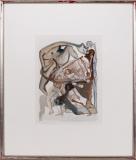Divine Comedy I
woodcut, 1950-1969, 25,5 x 18 cm, framed, An important Catalan painter with a distinctive handwriting was accepted into the group of Parisian surrealists in 1929, after collaborating on Buñuel's film Andalusian Dog. However, the free-spirited artist, who craved visibility and money and was not averse to appearing in commercials, had to leave the group before long. From a commercial artist, under the influence of a certain insight, he became a devout Catholic after the Second World War, which surprised everyone. During his lifetime, Dalí created drawings, paintings, graphics, sculptures, but also designed jewelry, theater costumes, perfumes, and more. Book illustrations are also a significant part of the work. A set of one hundred watercolors for Dante Alighieri's Divine Comedy was commissioned by the Italian government in 1957 for the 700th anniversary of the poet's death. The project was highly controversial, as the artist was not Italian. Under public pressure, the offer was eventually withdrawn. The order was renewed by Pope Pius XII, who found a sponsor in the person of Joseph Foret. Dalí did not allow himself at all the pressure created by the tradition of processing the work by artists such as Sandro Botticelli, Miguel Ángel or Gustave Doré. But it helped him to understand the meaning of the work, and he incorporated inspirations from baroque and renaissance art styles into his elaborate drawings in a surrealist spirit. Individual sheets are crowded with figures in tense poses, often signifying ecstasy or agony. The hard-to-grasp stories that Dante tells using brilliant poetic abbreviations, the artist tries to capture with his refined feeling for building dreamscapes, gestures and figures in motion. Although it is an extensive set of illustrations, the artist does not slavishly refer to the environments described in the books, but leaves the scenes open to interpretation. The inconsistency of the manuscripts that Dalí uses to capture a specific subject as best as possible is also interesting. The more drastic scenes have an almost poisonous color and feature elongated figures full of sharp edges. Neutral and positive themes, on the other hand, use large classicist surfaces with a muted color palette, and the figures seem to drown in the splendor of the surrounding environment.
Provenance: Antiquarian Dlážděná
Literature: listed R. Michler/ L. W. Löpsinger: Catalogue Raisonné of Prints II Lithographs and Wood Engravings 1956-1980, Prestel-Verlag Munich and New York 1995 under no. 1039 - 1138
studied at The Academy of Arts in Madrid at the atelier of prof. Moreno y Carbonero
ID: 3
Auction price: 5.500 CZK (230 €)
AUCTION IS TERMINATED: 12. 10. 2023 17:06
Current price: 6.500 CZK (271 €)
Last auctioneer: ID4**4 History of bids





